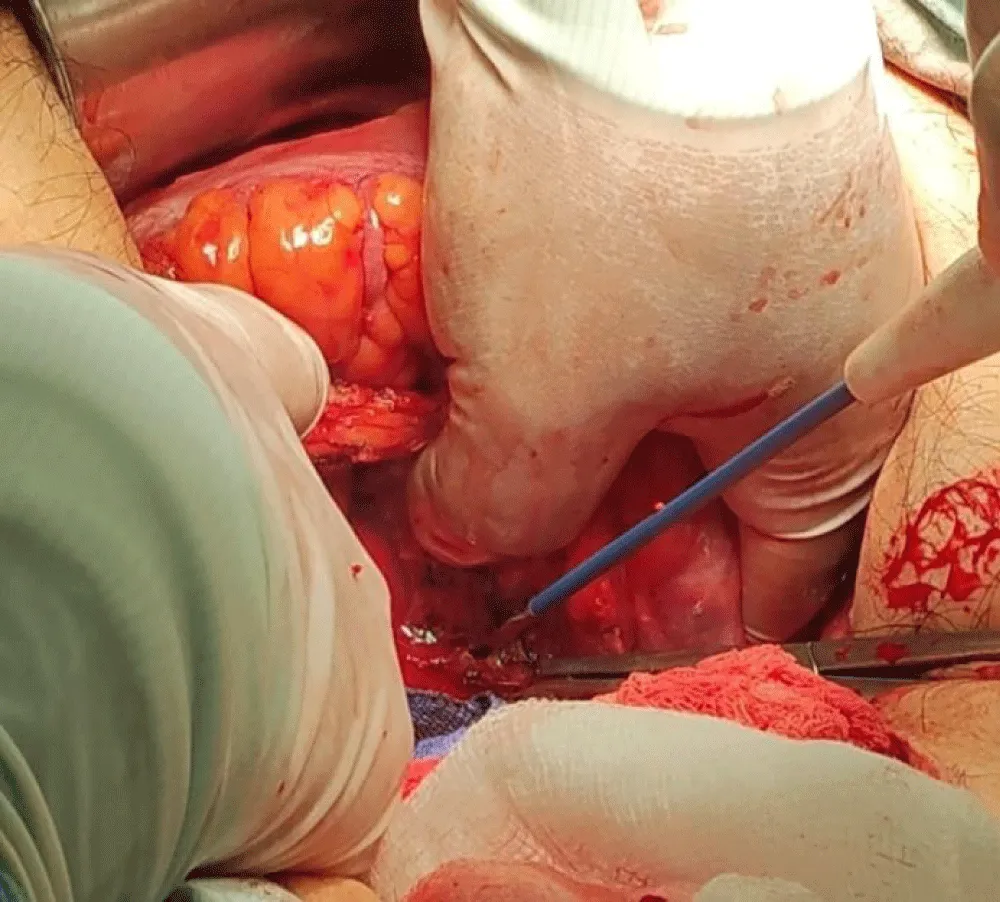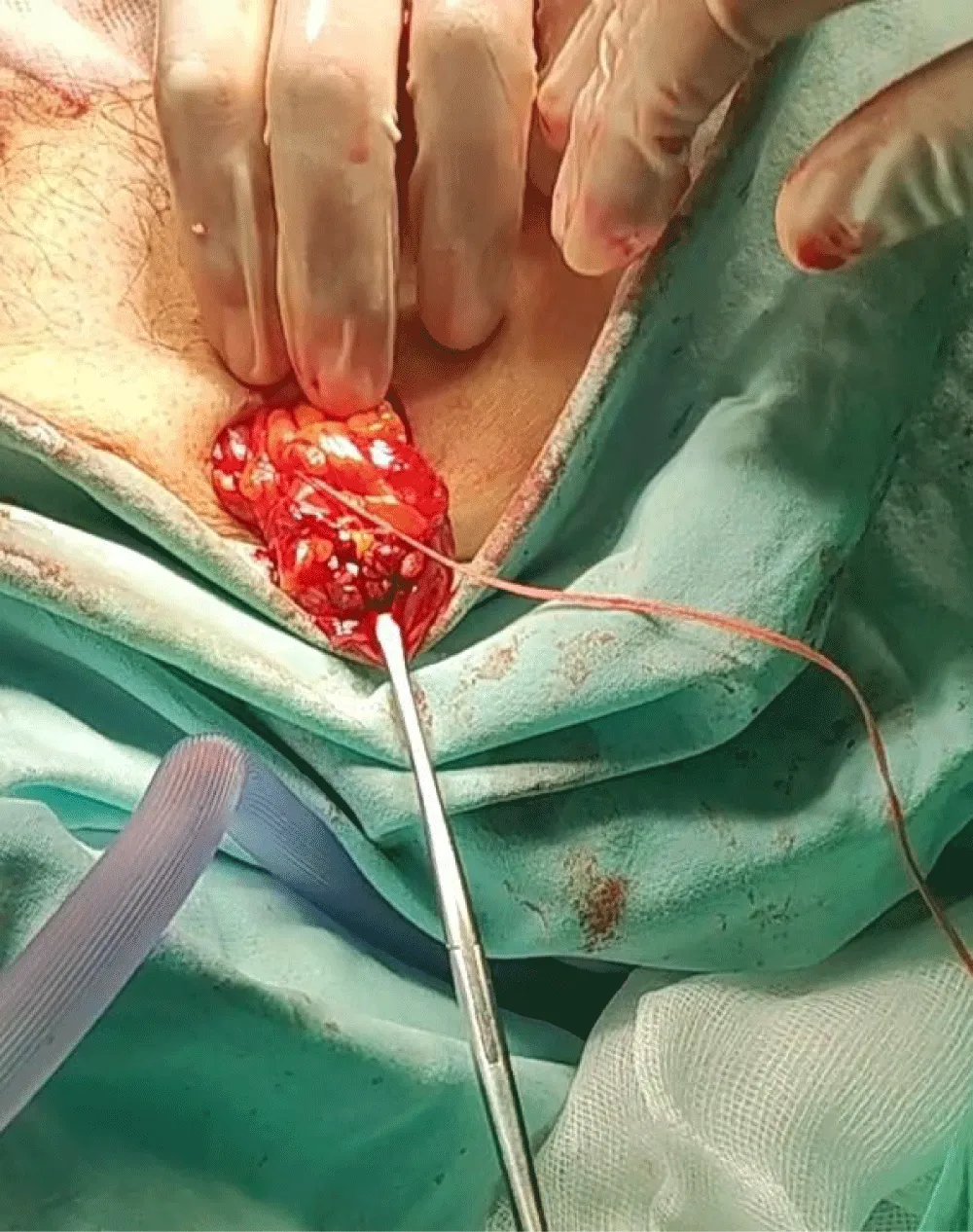Archives of Hepatitis Research
Bowel Obstruction Associated with Dolichocolo
Saavedra Asencios Jimena*
Cite this as
Jimena SA. Bowel Obstruction Associated with Dolichocolon. Arch Hepat Res. 2024;10(1): 001-004. Available from: 10.17352/ahr.000036Copyright License
© 2024 Jimena SA. This is an open-access article distributed under the terms of the Creative Commons Attribution License, which permits unrestricted use, distribution, and reproduction in any medium, provided the original author and source are credited.Background: Dolicocolon is an elongation of the colon at the level of any segment, but since it is uncommon, it does not have extensive literature.
Case presentation: A 68-year-old woman was admitted to the emergency department with nausea and vomiting, with no other symptoms found. With the help of imaging tests, bowel obstruction was detected due to sigmoid dolichocolon.
Conclusion: The case we describe is relevant as it is a rare clinical entity, such as dolichocolon which is associated with bowel obstruction, which is considered a risk factor for its development.
Abbreviations
HR: Heart Rate; RR: Respiratory Rate; BO: Blood Oxygen; BP: Blood Pressure; MN: Malignant Neoplasm; MRI: Magnetic Resonance Imaging; EL: Exploratory Laparoscopy; PRN: Pro Re Nata “when required”
Introduction
Dolichocolon is a very rare pathology, with unknown etiology but characterized by the elongation of the colon, mostly in the sigmoid colon [1]. Its colonic elongation can affect the entire colon but is mostly limited to a single segment and this is not dilated, since, if it were, it would become a megacolon [2]. Although there is debate about whether dolichocolon causes symptoms, it is usually associated with chronic constipation, abdominal pain, and distension, as well as hypotonia and hypocontractibility of the colon, which can contribute to difficulty passing stool and increases the risk of a partial or complete intestinal obstruction [3]. According to the literature, despite the rarity of the pathology, it may coincide with other intestinal pathology, such as recurrent clinical pictures of intestinal obstruction, also the absence of an anatomical obstructive process [4], such as a paralytic ileus refers to a decrease or partial interruption of intestinal transit without a real physical obstruction in the intestine, different from a complete obstruction since there is still some flow through the intestine, but it is decreased or restricted [5], symptoms may include constant colic abdominal pain, located in the lower quadrant, predominantly left, although depending on its location and severity of the blockage is that can cause diarrhea or constipation, abdominal distension, as well as nausea and vomiting [6]. While a bowel obstruction can become a serious condition that requires immediate medical attention, in which in some cases, the presence of a dolichocolon could be related [7]. The treatment may vary depending on the underlying cause and the severity of the obstruction. Next, I will present the case of a patient with bowel obstruction associated with dolichocolon who is referred to the Central Military Hospital due to nausea and vomiting but initially does not present other symptoms for diagnosing the pathology.
Case report
A 68-year-old female patient with a past medical history of hypertension under treatment was admitted to the emergency department of the Geriatric Military Hospital in Chorrillos, Lima, Peru, due to vomiting and nausea (food content) in the last 2 hours. The patient’s medical history was taken with no other symptoms reported, and vital signs were recorded: Temperature 37.9 °C, HR: 102 bpm, RR 17 bpm, BO 97%, BP 180/90 mmHg (hypertensive). Despite administering dimenhydrinate and omeprazole, when the patient was re-evaluated, the nausea and vomiting continued, now with bile content, so she was referred to the Central Military Hospital (Jesús María, Peru). A new anamnesis was carried out together with her eldest daughter, who indicated that her mother had been constipated in recent days and that 2 months ago the patient had abdominal pain, so they went to the gastroenterology service of the Military Geriatric Hospital, where an upper gastrointestinal endoscopy was performed due to suspected gastric ulcer, but the diagnostic impression turned out to be a micronodular and atrophic gastropathy of the antrum with severe duodenal reflux, without ruling out bowel obstruction, esomeprazole 40 mg every 12 hours and levosulpiride 25 mg every 8 hours intravenously was administered. It was decided to discharge the patient, suggesting that she do a simple abdominal x-ray and then make an appointment with the general surgery service to evaluate the digestive condition presented, which she did not do. Currently, upon admission to the emergency department of the Central Military Hospital, the patient did not present any pain in the abdominal area upon physical examination, the only symptom being vomiting. The presumptive diagnoses were diverticulosis and colon MN, so it was requested a complete blood count, an abdominal tomography, and an enter consultation with the general surgery department.
The complete blood count found the following results: Leukocytes 21.4 (leukocytosis), hemoglobin 17.1, hematocrit 51.3, MCV 86.3, MCH 28.8, lymphocytes 3.4%, monocytes 2.7%, eosinophils 0% and C-reactive protein 56 mg/L. The findings in the abdominal tomography suggest an inflammatory process in small intestinal loops at the level of the mesogastrium, left hypochondrium, left flank, and hypogastrium, which are associated with altered density of the adjacent mesentery, and small enlarged lymph nodes in the mesentery, moderate amount of free fluid in the abdominopelvic cavity, edema in the mucosa of the lower rectum, stomach with slightly thickened mucosa, suggesting selective evaluation by endoscopy and dolichocolon at the level of the sigmoid colon. The next day, when internal medicine was evaluating the patient, her condition worsened, she was found to be complaining of diffuse, colic-type abdominal pain of moderate intensity, increased hydro-air sounds, tympanic, painful on superficial and deep palpation with predominance in the lower abdomen, for which she was given ranitidine 50 mg, metamizole sodium 1 g and hyoscine n-butylbromide 20 mg intravenously, with the indication to administer it again only PRN in moderate pain, and the patient was placed in NPO. In the consultation with the general surgery department, new blood tests were ordered (complete blood count, coagulation profile, C-reactive protein, and urea) for surgical evaluation, as well as consultations with the terminology and cardiology departments. In the coagulation profile, the following was found: Partial thromboplastin time 39.10 seconds, prothrombin time 17.2 seconds (64%), INR 1.32. In the complete blood count, the general surgery department suggested resolving the patient’s anemia (hemoglobin 12) and leukopenia (leukocytes 11.7), so a 50 mg/ml injection of ferinject was administered intravenously; in addition to requesting an upper abdominal magnetic resonance. On the third day of hospitalization, the results of C-reactive protein (11.98 mg/L) and urea (14.6 mg/dl) arrived.
On the fourth day, an upper abdominal magnetic resonance was performed using a Turbo Spin Echo sequence, acquiring axial and coronal T2-weighted images, as well as T2 using the SPAIR fat suppression technique. The outstanding finding was a dilatation of the distal iliac loop with narrowing of the normal tubular volume at the jejunoilial level suggestive of intestinal subocclusion, concluding that intestinal subocclusion should be considered according to the description, meriting correlation with the patient’s clinical picture. In the new consultation with the general surgery department is observed an improvement in the patient’s blood count, in addition to the approval evaluation by the neumonology and cardiology services, together with the radiological report of the requested MRI, scheduled the surgery for the following day, indicating that a last coagulation profile should be performed 3 hours before the surgery.
On the day of the surgery, the coagulation profile obtained the following results: Partial thromboplastin time 36.10 seconds, thrombin time 15.4 seconds, prothrombin time 15.2 seconds (77%), INR 1.16. In the surgery, the operative report indicates the procedure, a supra and infra umbilical incision is made up to the cavity, identifying an internal sigmoid hernia that strangles a portion of the thin loop 1 meter from the angle of Treitz, the thin loop is reduced and released, closing the hernial defect (Figure 1), then the cavity is washed, as well as the hemostasis check, to finally place a tubular drain in the recto-bladder space (Figure 2). The surgery was successful without any surgical complications. In the postoperative period, oral tolerance with sugary liquids is tested with a nasogastric tube, 5% dextrose is administered 1000cc, 2 injections of 20% NaCl and 1 injection of 20% KCl in 45 drops intravenously; cefepime 1 g, metronidazole 500 mg, ketoprofen 100 mg, levosulpiride 25 mg and simethicone 80 mg/ml 60 drops every 8 hours intravenously; esomeprazole 40 g every 24 hours intravenously, PRN tramadol 100 mg is indicated for intense pain, and 1 captopril tablet 25 mg orally if BP > 160/90 mmHg, on the second postoperative day the medication is continued adding the possibility of physical activity (mobilization from bed to chair) of the patient. On the third day, she is discharged.
Discussion
This case report turns out to be of medical relevance because despite what was indicated in the MRI radiological report, there was an endoscopic history of bowel obstruction, which was confirmed during surgery when an internal hernia with a strangulated small bowel was found, which indicates that dolichocolon turns out to be concomitant with the patient’s mechanical bowel obstruction. However, it turns out to be a rare clinical entity that, according to the existing literature, we do not find the “typical” characteristics in the patient, a woman born on the coast of Peru, considering that an observational, descriptive study [8] was carried out that compiled different cases of Andean dolicomegacolon (megacolon) in the Andean zone of our country during a long period, concluding that it is a disease acquired over the years that initially does not present symptoms, it is usually frequent in male patients, between 40 - 70 years of age in the Andean rural area with a history of chronic constipation, it is also highlighted that sigmoid volvulus about bowel obstructions occur in a high percentage, relating the importance of altitude with the pathogenesis and that these genetic, environmental and dietary factors of the population make its diagnosis a challenge. Although the surgical procedure chosen was mainly due to the location of the hernia, a Hartmann colostomy may be debatable. In the cases collected in the article “Andean megacolon and sigmoid volvulus at high altitude” [8], the vast majority of patients received surgical treatment with a sigmoidectomy with primary anastomosis with viable intestine, and a smaller number, similar to our patient in this case report, underwent a Hartmann’s pouch colostomy, but it is this same article that points out the low morbidity and mortality of the Hartmann colostomy compared to a sigmoidectomy with primary anastomosis. Furthermore, the article “Management of the colonic volvulus in 2016” [9] concludes that there are no differences in mortality between Hartmann’s pouch colostomy and resection with anastomosis, both options being safe for the patient.
Conclusion
The presence of dolichocolon as a concomitant of bowel obstruction is very rare, especially in women from the coastal area of Peru. The surgical technique used should be focused according to the clinical condition of the patient, the size of the hernial defect, concomitant pathologies, and the experience of the surgeon. Therefore, it is suggested that this case report be considered for further study so that the literature on this clinical entity can be expanded.
Author contributions
Jimena Alessandra Saavedra Asencios: Conceptualization, data curation, formal Analysis, writing.
Statement of ethics
Ethical approval was not required to publish this case report, nor did the retrospective review of patient data require ethical approval, following the national guidelines. Written informed consent was obtained from the patient for publication of the details of their medical case and any accompanying images.
- Pastor DraCL, López DraRE, Miguel DrIC, Sempere DraRO. Most relevant radiological findings in Chagas disease. Seram. 2022;1(1):36. Available from: https://piper.espacio-seram.com/index.php/seram/article/view/8860
- Mera-Martínez PF, Rivas-Goyes JA, Portillo-Miño JD. Megadolichocolon with an unusual presentation in an elderly patient: a case report. Colomb J Surg. 2024;35(4):695–8. Available from: https://www.revistacirugia.org/index.php/cirugia/article/view/487
- Chronic constipation: a review of the evidence. Nature Clinical Practice Gastroenterology & Hepatology. 2005;2(3):123. Available from: https://www.nature.com/articles/ncpgasthep0125
- Joubert Álvarez G, Dario R, Campos R. Intestinal occlusion due to renal cyst: presentation of a unique case. Annals Cub Acad Sci. 2021;11(3):993. Available from: https://revistaccuba.sld.cu/index.php/revacc/article/view/993/1233
- Amaya Macías RM, Hernández Requejo M, Serrano Hernandez R, Arbués Martínez C, Reyes López Á, López Ramón R. Summary of intestinal subocclusion in a patient with colon adenocarcinoma. Clinical case. Rev Sanitaria Investig. 2022;3(1):68. Available from: https://dialnet.unirioja.es/servlet/articulo?codigo=8298459&info=resumen&idioma=ENG
- Intestinal subocclusion. Regarding a case. Revista Sanitaria de Investigación. Available from: https://revistasanitariadeinvestigacion.com/suboclusion-intestinal-a-proposito-de-un-caso/
- Jesús Ladra González M, Amigo Souto F, Bustamante Montalvo M. Seudoobstrucción intestinal crónica. Gastroenterol Hepatol. 2011;34(9):665–6. Available from: https://www.elsevier.es/es-revista-gastroenterologia-hepatologia-14-articulo-seudoobstruccion-intestinal-cronica-S0210570511002305
- Borda Medero L, Kcam Mayorca EJ, Alarcon Aguilar P, Miranda Rosales LM. Andean megacolon and high altitude sigmoid volvulus. Presentation of 418 cases between 2008 - 2012 at the C. Monge hospital – Puno, Peru. J Gastroenterol Peru. 2017;37(4). Available from: http://www.scielo.org.pe/scielo.php?script=sci_arttext&pid=S1022-51292017000400004
- Perrot L, Fohlen A, Alves A, Lubrano J. Management of the colonic volvulus in 2016. J Visc Surg. 2016;153(3):183-92. Available from: https://doi.org/10.1016/j.jviscsurg.2016.03.006
Article Alerts
Subscribe to our articles alerts and stay tuned.
 This work is licensed under a Creative Commons Attribution 4.0 International License.
This work is licensed under a Creative Commons Attribution 4.0 International License.




 Save to Mendeley
Save to Mendeley
